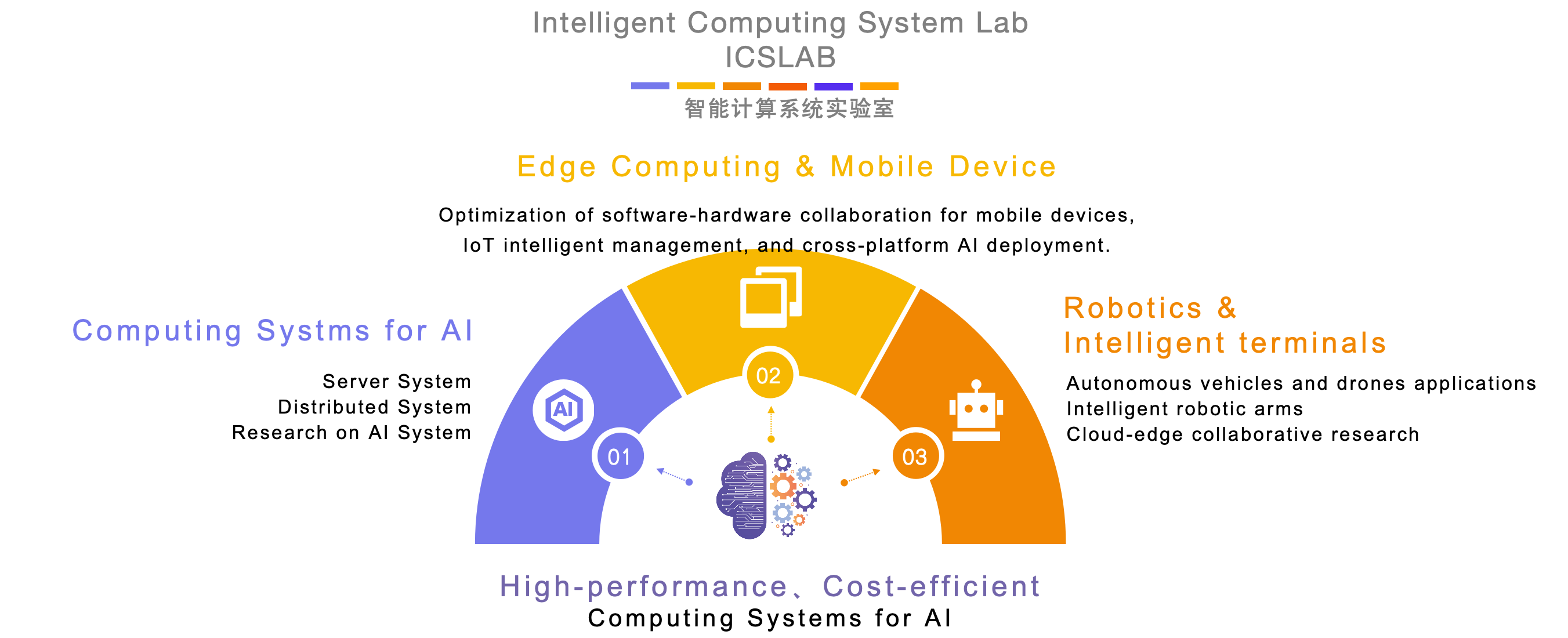Computing Systems for AI
We focus on research in artificial intelligence computing systems, aiming to achieve continuous breakthroughs in performance and energy efficiency through co-design of software and hardware. Our research includes:
1. AI-related Research: Key areas include algorithm and architecture optimization for large language models (LLM), deep neural networks (DNN), and graph neural networks (GNN). We explore model quantization techniques to reduce computational complexity and storage requirements, develop efficient AI compilers to improve execution efficiency across multiple hardware platforms, and implement cross-platform application optimization with a focus on inference performance to enhance real-time capabilities and resource utilization.
2. Systems-related Research: This involves investigating architectural design and performance optimization for traditional CPUs, high-performance GPUs, and heterogeneous computing units (XPUs). We study collaborative computation and resource allocation in multi-workload scenarios to enhance computational efficiency, delve into memory technologies to explore efficient data access and memory management strategies, and optimize compute-storage scheduling and task allocation to improve the utilization of storage and computational resources. Additionally, we focus on distributed system architecture design to enhance coordination in distributed environments, optimize the efficiency and fault tolerance of distributed AI models.
Edge Systems & Mobile Devices
We focus on optimizing the collaboration of software and hardware for edge and mobile devices, proposing efficient task scheduling and resource management strategies tailored to AI scenarios, and exploring cross-platform AI model deployment and IoT intelligent management applications. Our research includes: AI scenarios on mobile devices, focusing on task scheduling and collaborative computing strategies for CPUs, GPUs, and XPUs; optimizing CPU dynamic frequency scaling and load distribution to enhance power control and performance balance; conducting research on critical thread tracking and priority scheduling to improve real-time response and resource utilization; and exploring new hardware platforms (e.g., NVIDIA Jetson ORIN) to optimize their performance in AI applications. We also design IoT intelligent management systems, proposing efficient resource scheduling and data management strategies for IoT devices to enhance system stability and service capability. Additionally, we explore lightweight deployment methods for AI models tailored to edge and mobile devices, optimizing execution efficiency across multiple hardware platforms to drive the widespread adoption of AI applications on edge devices.
Robotics & Smart Terminals
Robotics and smart terminals are important application scenarios of artificial intelligence computing systems and indispensable technologies of the future. Our research focuses on the theoretical optimization and practical application of intelligent devices such as autonomous vehicles, drones, and robotic arms, aiming to promote the widespread adoption of smart terminals to benefit society. Our research includes:
1. Autonomous Vehicles and Drones: Exploring intelligent navigation and decision-making technologies for autonomous vehicles in complex environments to improve task efficiency and safety; studying task scheduling and flight control for drones to optimize their performance in diverse scenarios; developing collaborative solutions for autonomous vehicles and drones, applicable to scenarios such as emergency response and logistics, to achieve efficient multi-device coordination.
2. Robotics Research: Studying intelligent control and task allocation for robots like robotic arms to support precise operations in industries and services. We optimize collaborative tasks between robots and other smart terminals to enhance system integration and task flexibility, advancing intelligent manufacturing and automation development.
